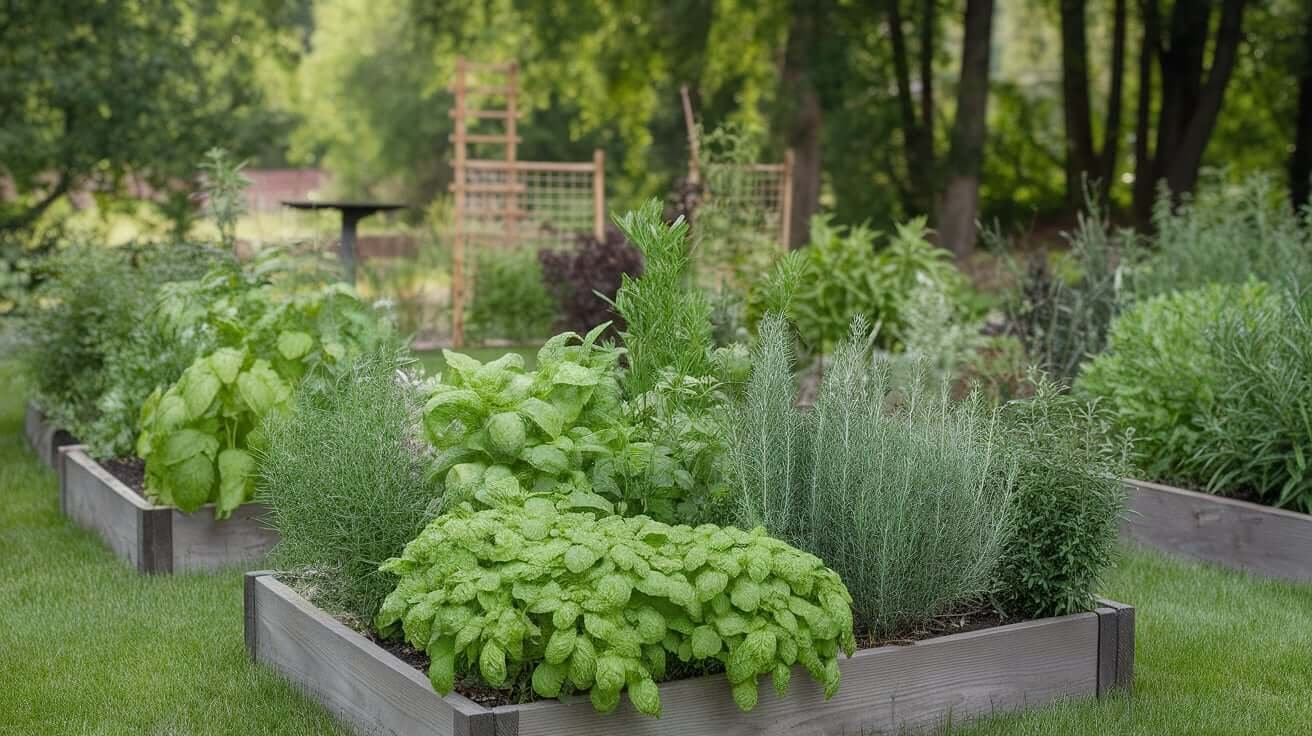18 Best Herb Garden Ideas for Your Home & Kitchen
Growing your own herbs is more than just a hobby; it’s a lifestyle upgrade. Imagine stepping outside or reaching to your windowsill and plucking fresh basil for your pasta or mint for your refreshing summer drink.
No matter, if you’re a seasoned green thumb or just starting, cultivating an herb garden is a truly rewarding and practical experience.
If you’re ready to grow herbs but looking for inspiration, we’ve got you covered. This article will explore 18 creative herb garden ideas, practical tips for success, and answers to common questions to help you get started.
Why Grow Your Own Herb Garden?
An herb garden has numerous benefits that go beyond the deliciously fresh flavors it adds to your meals:
- Cost savings: Save money by growing your own herbs instead of buying expensive store-bought bundles that wilt quickly.
- Freshness: There’s nothing better than snipping herbs seconds before using them.
- Aesthetic appeal: Herb gardens can be a charming addition to any home or yard.
- Sustainability: Reduce waste and eliminate the need for plastic-packaged store herbs.
Now, let’s get inspired with some herb gardening ideas.
18 Herb Garden Ideas
1. Raised Garden Beds
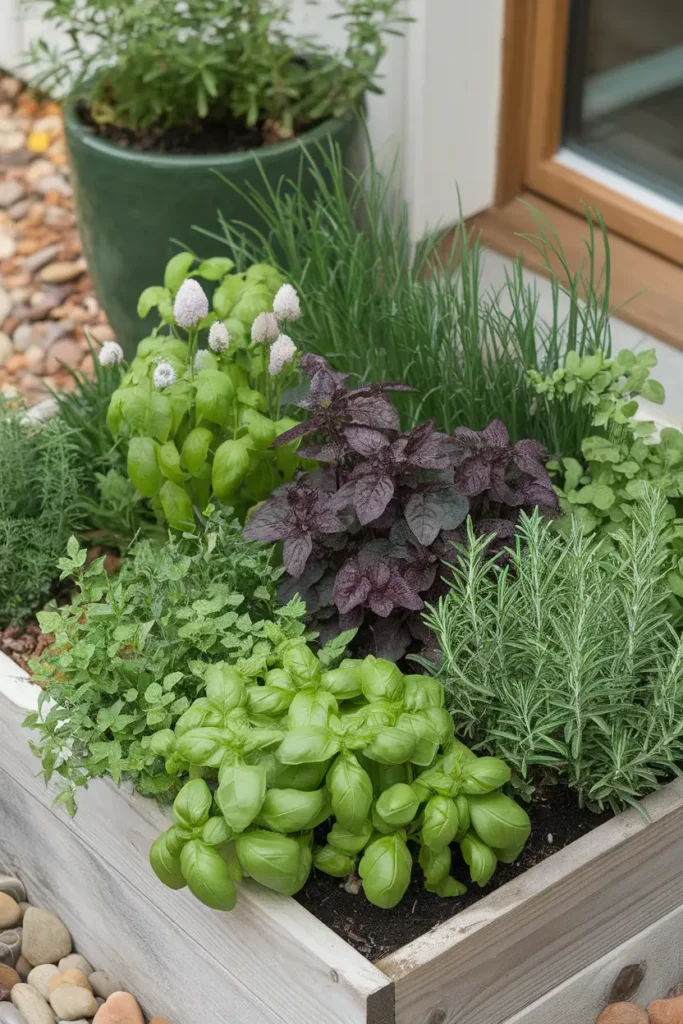
Plant herbs in raised garden beds to improve drainage, protect roots from waterlogging, and provide better protection from pests like slugs.
Raised beds also make gardening more accessible by reducing the need to bend down, which is great for people with back issues or limited mobility.
This option is especially ideal for outdoor spaces, offering a clean, organized look to your garden while maximizing growing space for herbs like basil, chives, and oregano.
2. Kitchen Windowsill Herb Garden

Brighten your kitchen with small pots of fresh herbs like basil, thyme, or rosemary growing right on your windowsill.
This setup is perfect for cooking enthusiasts, as easy access to fresh herbs means you can snip exactly what you need while cooking, adding flavor and aroma to your dishes.
Plus, it adds a touch of greenery to your kitchen, creating a cozy and inviting ambiance.
3. Vertical Herb Garden

Short on space? A vertical herb garden is a smart solution for growing multiple types of herbs while using minimal floor area.
Install a trellis, stacked pots, or even a hanging wall planter to create a functional and visually appealing display.
Herbs like parsley, mint, and cilantro thrive in vertical setups, making them ideal for apartments, balconies, or smaller outdoor spaces.
4. Terracotta Pot Collection

Plant herbs like oregano, parsley, rosemary, or lavender in rustic terracotta pots for a timeless and charming look.
These pots offer excellent drainage and help regulate soil moisture, which is essential for healthy herb growth.
Arrange them on shelves, steps, or patios to create a stunning display that blends seamlessly with any garden design or decor style.
5. Hanging Herb Baskets
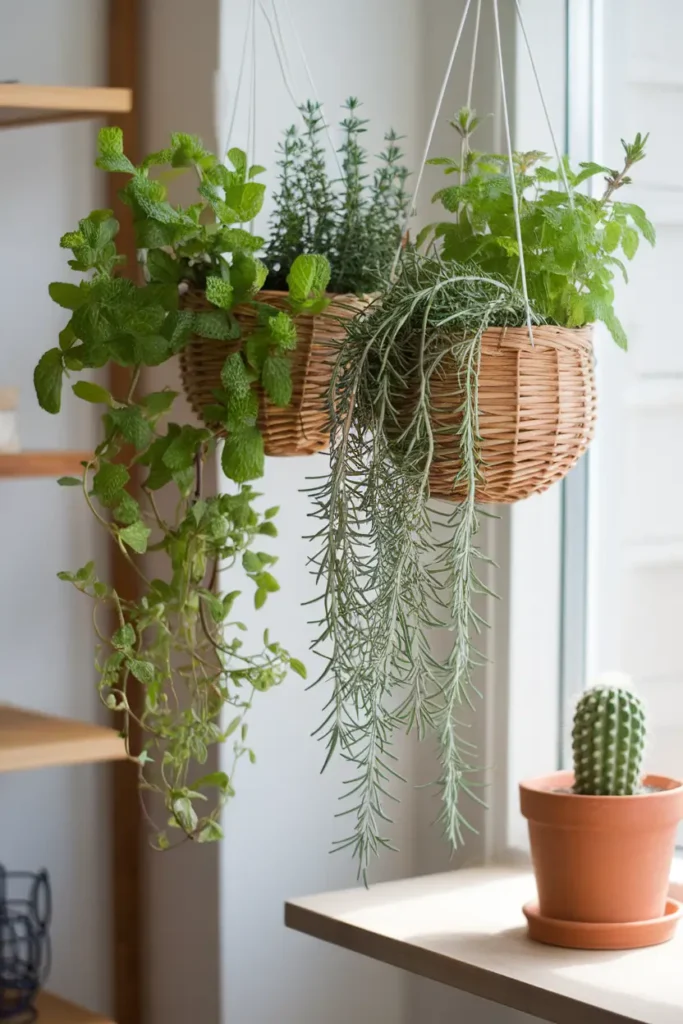
Hang baskets of herbs like mint, thyme, or trailing rosemary near a sunny window, patio, or balcony railing.
These baskets save space, look visually striking, and keep your herbs out of reach from curious pets or small children.
They’re also easy to water and maintain, and their elevated position allows for better air circulation, preventing disease and pests.
6. Mobile Herb Garden
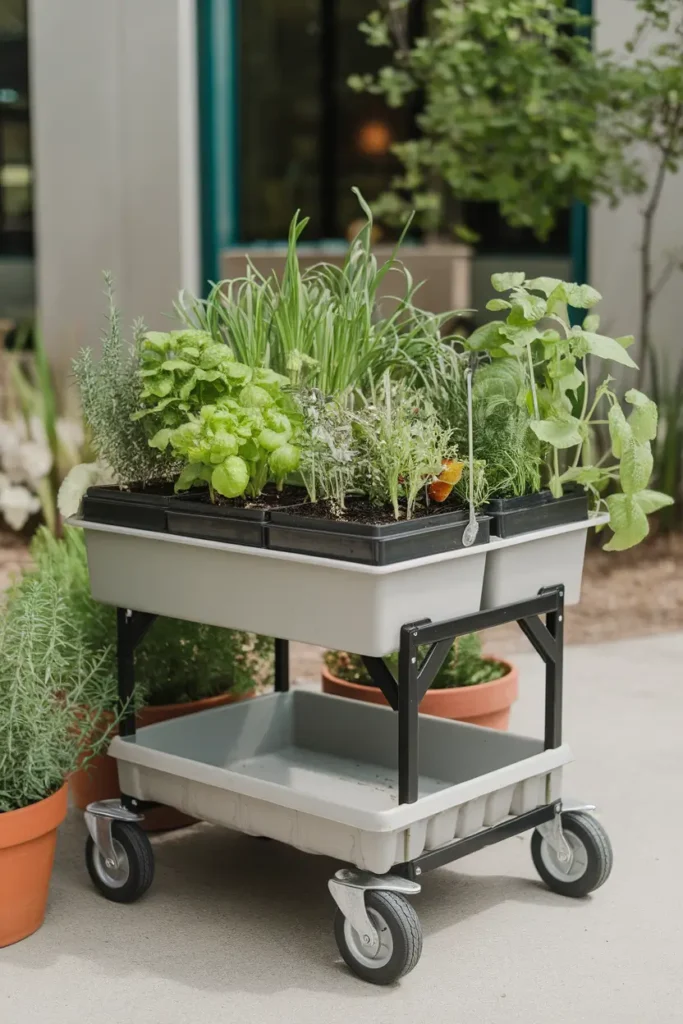
Use a portable planting tray or wheeled cart to create a mobile herb garden that can follow the sunlight throughout the day or be brought indoors during colder months.
This setup is perfect for year-round growing, especially for herbs like basil and cilantro, which are sensitive to frost.
A mobile garden adds flexibility and is great for homes with unpredictable weather or limited outdoor space.
7. Hydroponic Herb Garden
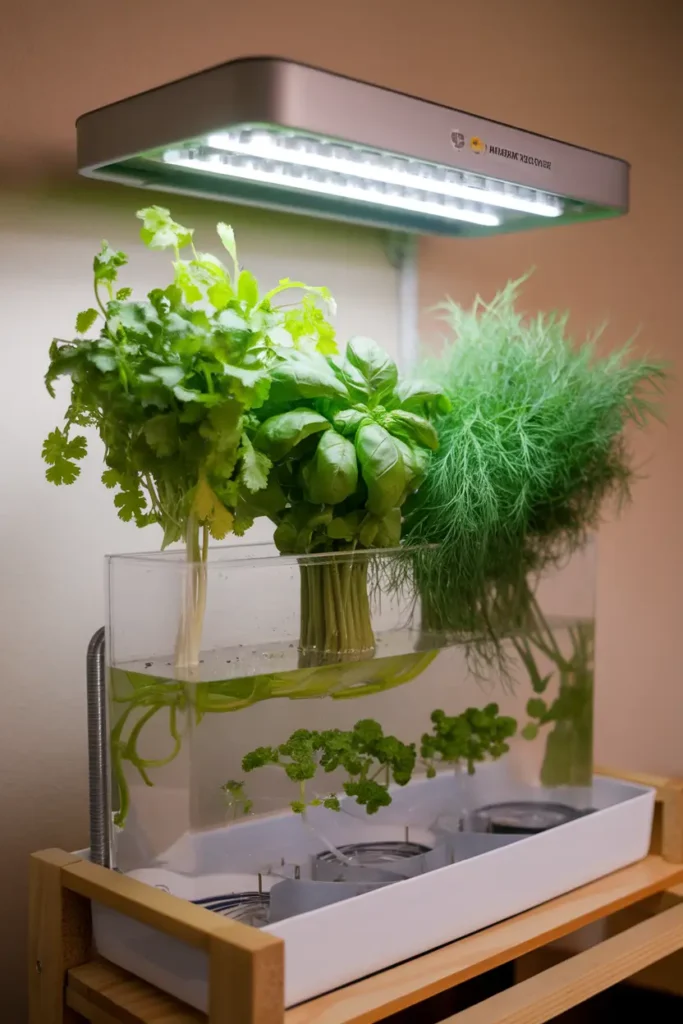
No soil? No problem! Hydroponic systems allow you to grow herbs like cilantro, basil, or dill using nutrient-rich water instead of soil.
This indoor solution is perfect for those with limited space or no garden access, as it requires minimal maintenance and provides a highly efficient way to grow fresh herbs.
Many hydroponic kits come with built-in LED lights, making it easy to grow herbs even in darker rooms.
8. Pallet Herb Garden
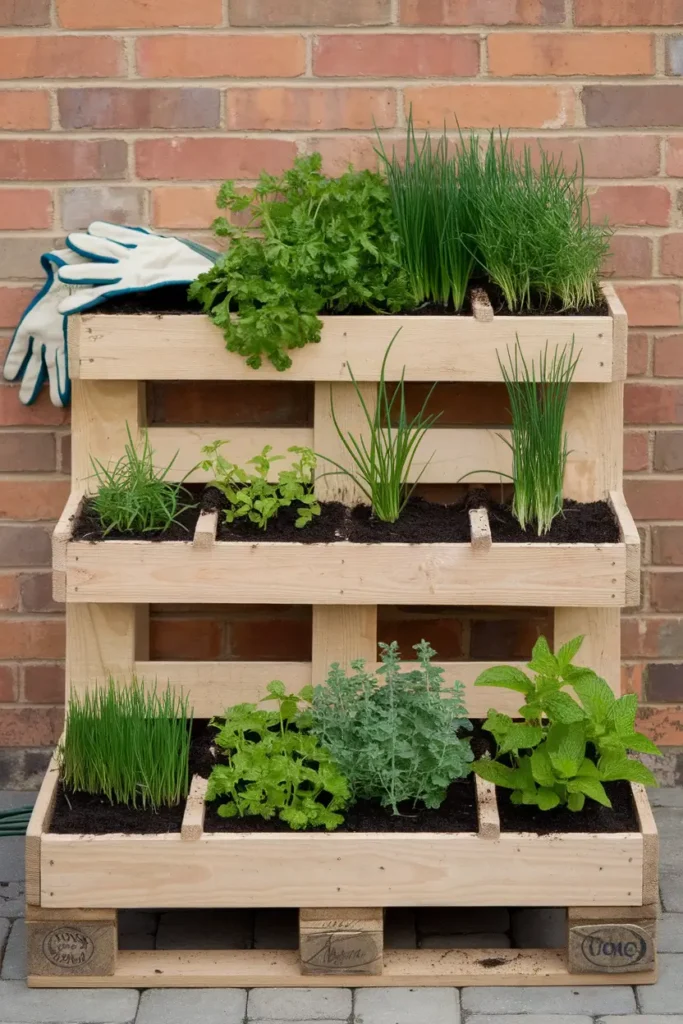
Recyclable wooden pallets make excellent frames for herb gardens, providing a rustic and eco-friendly setup.
Their individual compartments are perfect for planting a variety of herbs, such as parsley, chives, and mint.
Lean the pallet against a wall or prop it upright to save space, and consider painting or decorating it to add a personal touch to your garden design. It’s a fun and sustainable way to grow your own herbs!
9. Herb Rock Garden
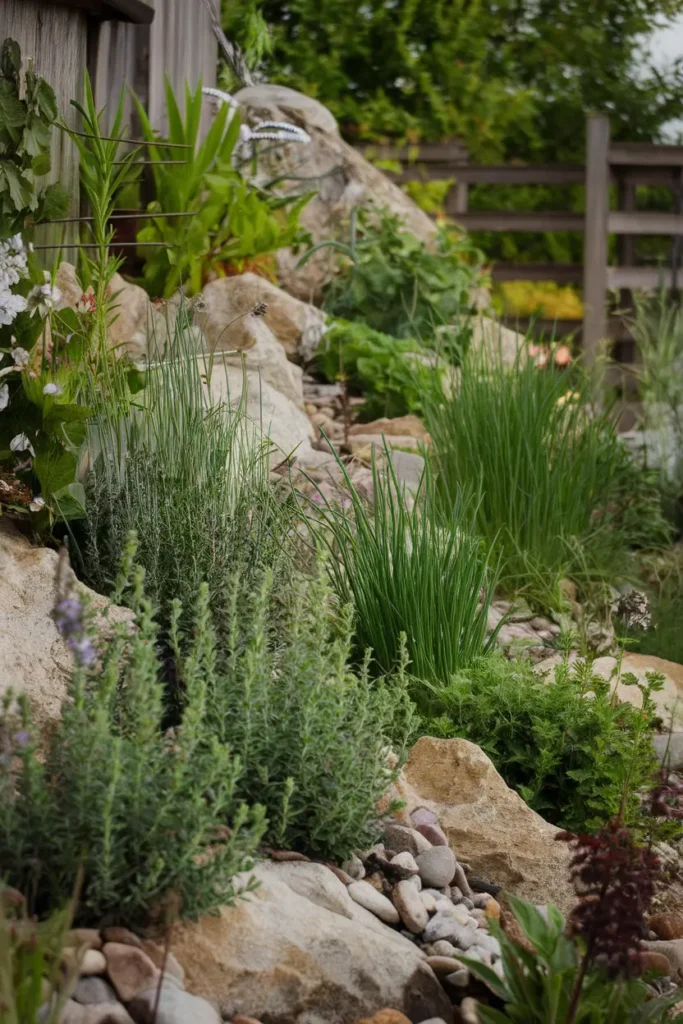
Add charm and texture to your yard with a stunning rock garden filled with herbs like creeping thyme, chives, or oregano.
These low-maintenance plants not only provide fresh ingredients for cooking but also create a natural, rustic aesthetic.
The rocks retain heat, which helps your herbs thrive, and the garden can be a focal point in your outdoor space.
10. Railing Planters
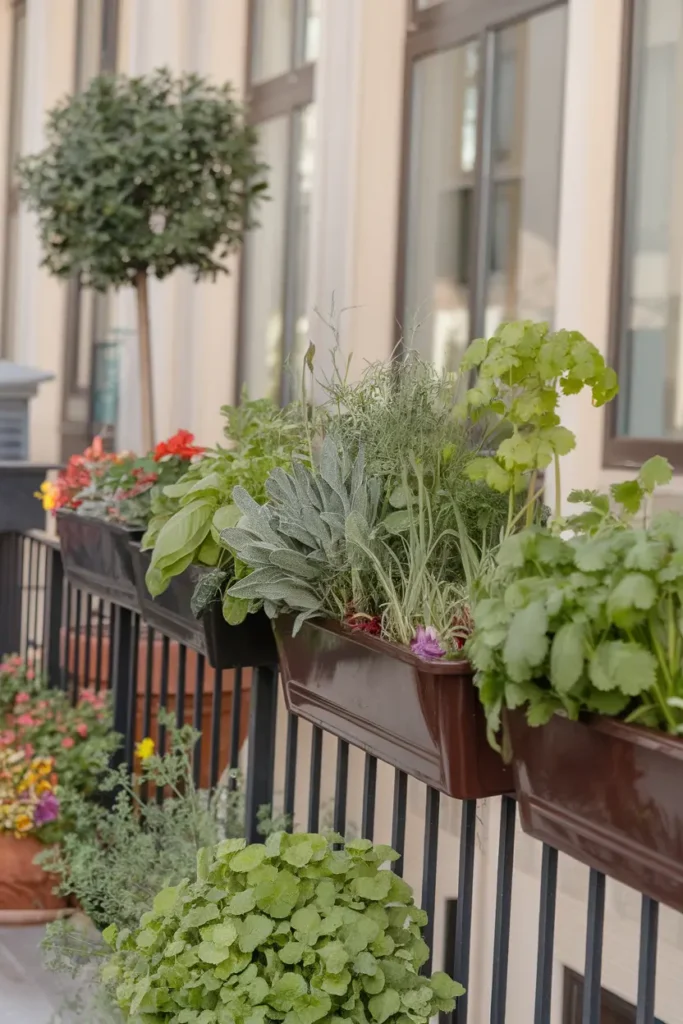
Maximize balcony or deck space by adding railing planters for a vertical herb garden. Herbs like basil, sage, and cilantro grow beautifully in these light-filled spots, making it easy to snip fresh leaves while cooking.
These planters are a fantastic solution for small spaces, adding greenery without taking up valuable floor space.
11. Companion Herb Garden
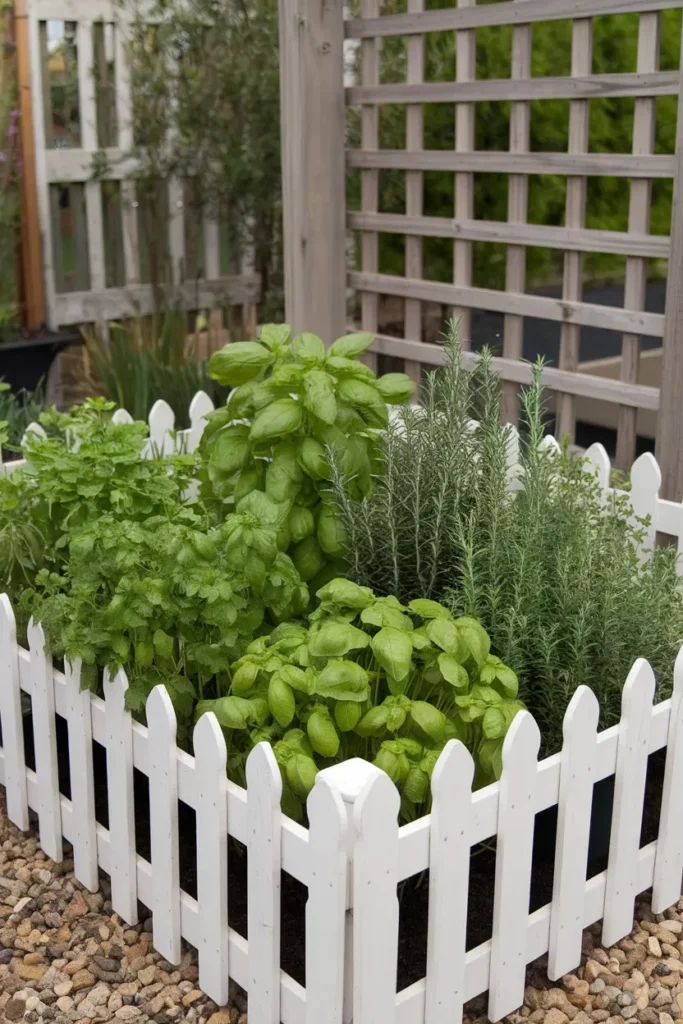
Plant herbs with similar growing needs side-by-side for a thriving and harmonious garden. For example, parsley and basil both prefer moist, nutrient-rich soil, while rosemary and thyme thrive in drier conditions.
Companion planting not only makes watering and care easier but also creates a visually cohesive and productive herb garden.
12. Large Wooden Crate
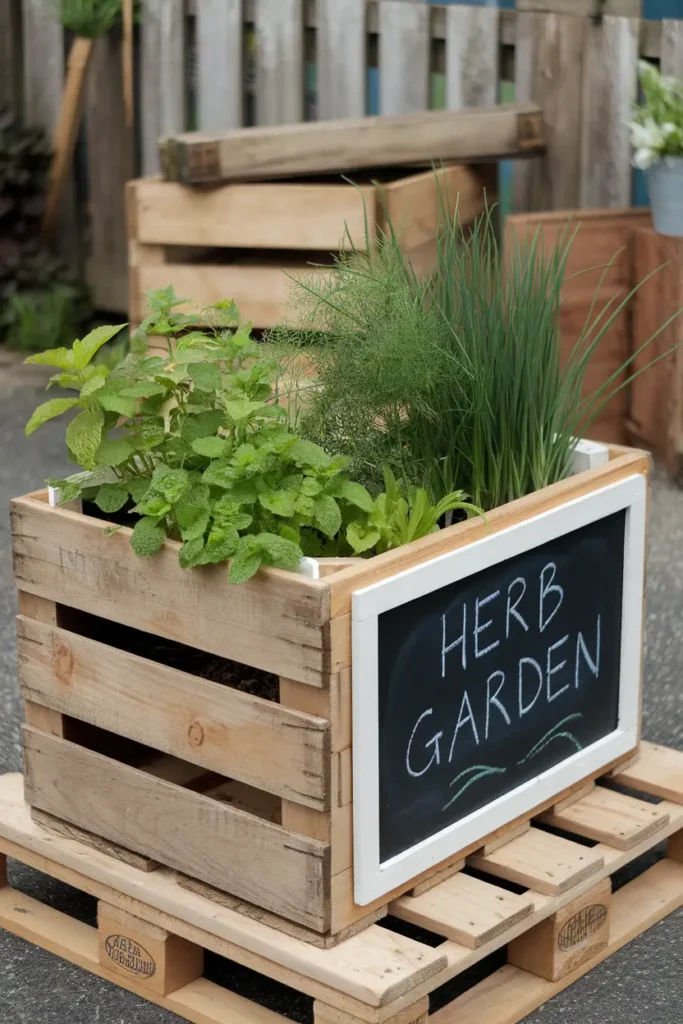
Upcycle a large wooden crate into a charming planter for grouped herbs. Line it with landscape fabric to retain soil, then plant herbs like mint, dill, and chives for a lush, organized setup.
Add labels or chalkboard paint for a rustic, personalized touch that’s both practical and stylish.
13. Herbs with Flowers
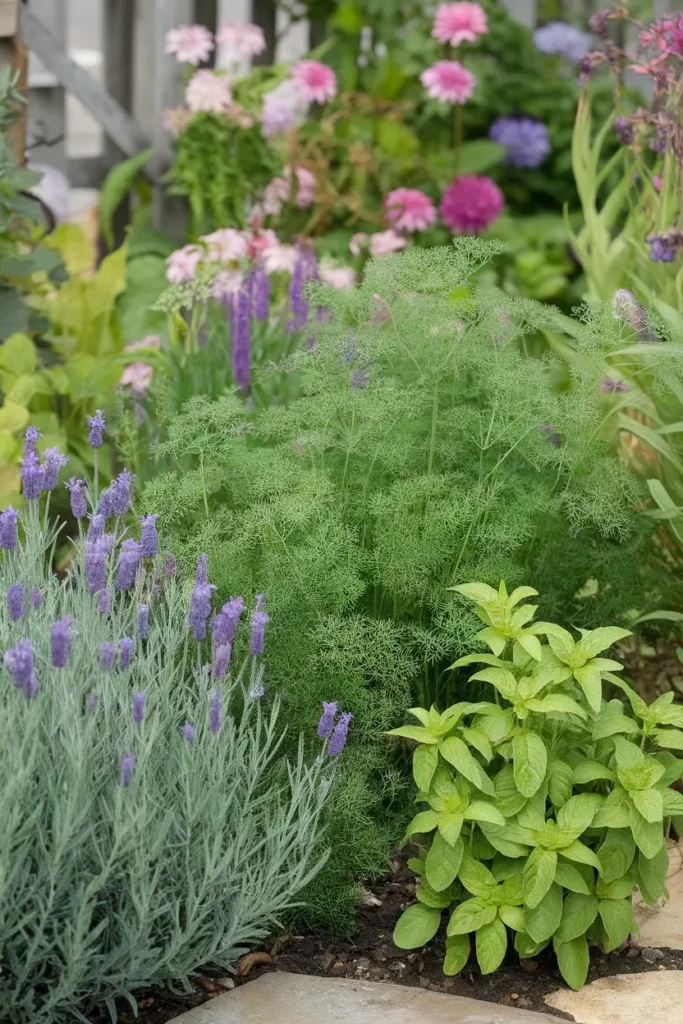
Combine herbs like lavender, dill, and Thai basil with flowering plants for a garden that’s as functional as it is beautiful.
This mix creates visual variety, attracts pollinators like bees and butterflies, and enhances the vibrancy of your outdoor or indoor spaces. Plus, flowering herbs like lavender also add a soothing fragrance.
14. Growing Herbs Indoors in Water
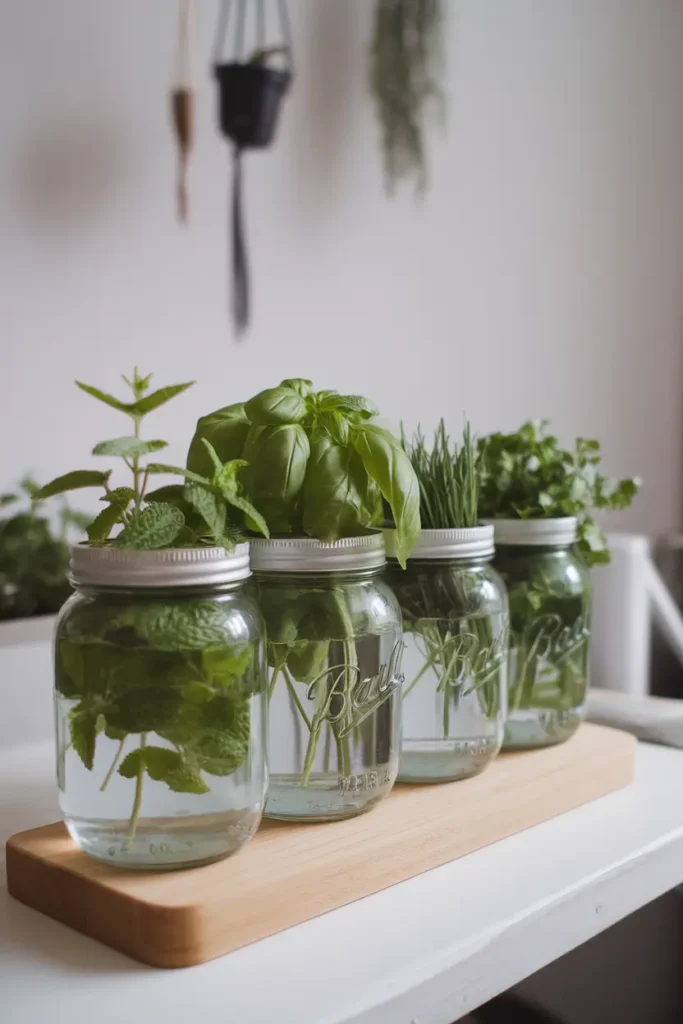
Certain herbs, such as mint, basil, or parsley, grow well in water and are perfect for creating a minimalist, soil-free garden.
Use Mason jars or glass bottles filled with water, and place them on a sunny windowsill or counter.
Not only do these jars add a sleek decorative touch, but they also keep your herbs fresh and easily accessible for cooking.
15. Bathroom Herb Garden

Humidity-loving herbs like basil, cilantro, or mint can thrive in a bathroom with enough sunlight. The humid environment mimics tropical conditions, helping these herbs flourish.
Place pots on a windowsill or hanging baskets near a window for an unconventional yet effective herb-growing solution that adds greenery to your bathroom.
16. Groundcover Herbs
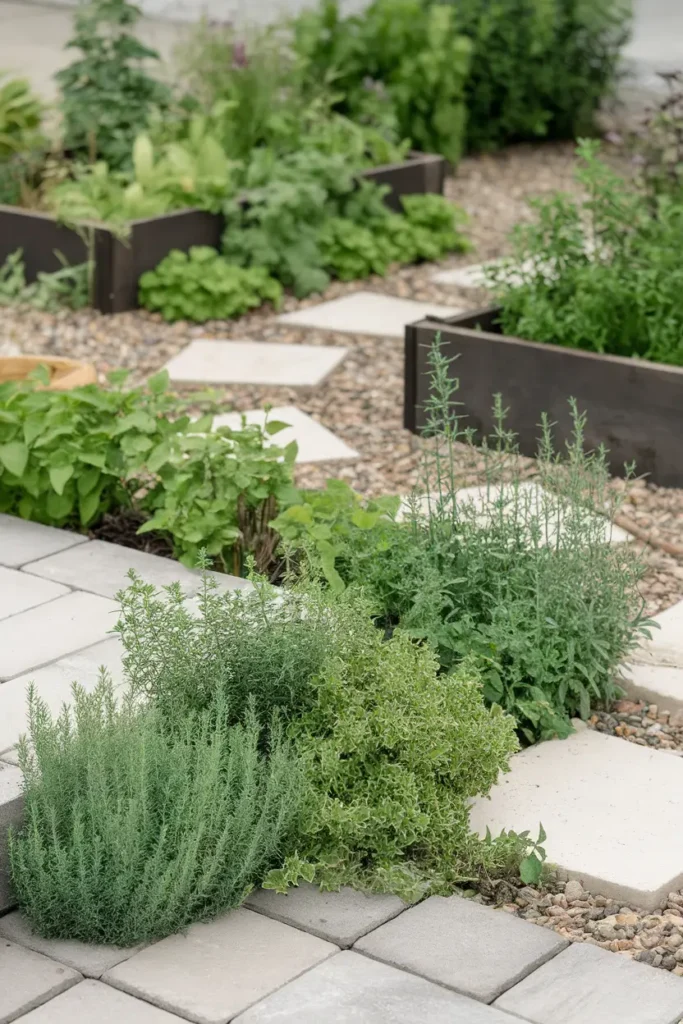
Creeping herbs such as thyme or oregano are perfect for edible landscaping. Use them to fill gaps between patio pavers, around stepping stones, or as a lush, fragrant garden border.
These hardy herbs can withstand foot traffic and add a soft, aromatic touch to pathways or garden spaces while doubling as a convenient cooking ingredient.
17. Herb Garden Table
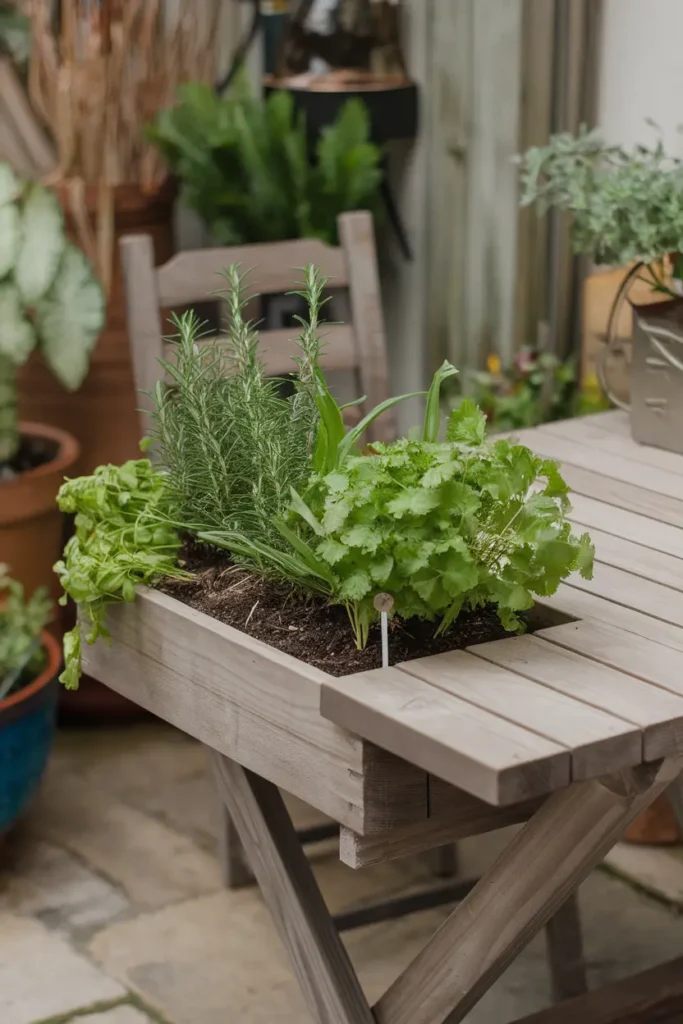
Combine style and functionality by investing in or building an herb garden table. These multifunctional pieces of furniture incorporate a built-in planter where you can grow fresh herbs like rosemary, cilantro, or parsley.
Perfect for compact spaces like balconies or patios, this setup keeps herbs within arm’s reach while doubling as a dining or work surface.
18. Cottage-Style Herb Garden
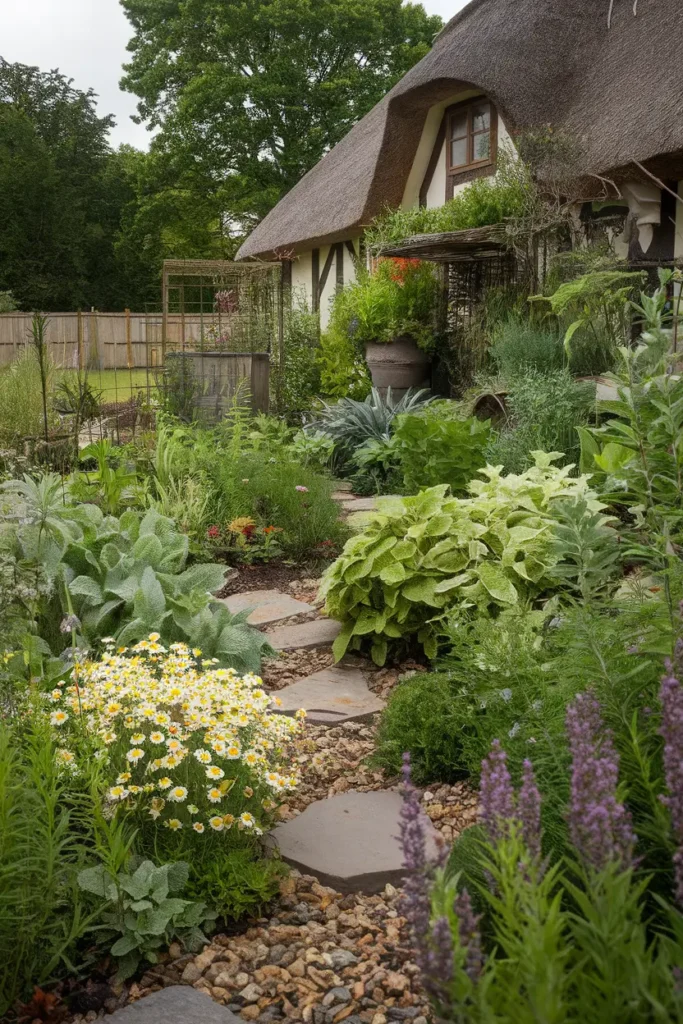
Create a whimsical, overflowing cottage-style herb garden with a mix of herbs like chamomile, bee balm, sage, and lemon balm.
This informal arrangement adds a natural, enchanting look to your yard while attracting pollinators like bees and butterflies.
Perfect for those who love a relaxed, romantic aesthetic, this garden style blends beauty and practicality effortlessly.
Tips for a Successful Herb Garden
Growing herbs doesn’t require a green thumb, but a few secrets will lead to consistent success:
- Group Plants with Similar Needs: Mediterranean herbs like rosemary, thyme, and oregano do well in dry conditions, while others like basil and parsley prefer more moisture. Keep similar plants together to simplify care.
- Prioritize Sunlight: Most herbs need at least 6-8 hours of sunlight daily. Indoors, set up near a south-facing window or use a grow light if natural light is limited.
- Use Well-Draining Soil: Poor drainage can cause root rot. Use soil specially designed for herbs, or mix potting soil with coarse sand for containers.
- Don’t Overcrowd Plants: Although it’s tempting to cram planters with multiple herbs for a lush appearance, herbs need space for air circulation. Adequate spacing helps prevent pests and diseases.
- Master Watering: Don’t overwater! Allow the top layer of soil to dry out before watering again. Over-moist soil can quickly kill your plants.
FAQs
Can you grow herbs indoors all year round?
Yes, many herbs like basil, rosemary, and mint can thrive indoors year-round with sufficient light and the right soil conditions.
What are the easiest herbs to grow for beginners?
Mint, basil, chives, and parsley are great starting points. They grow quickly, are low-maintenance, and adapt well to various environments.
How can you preserve herbs for later use?
Drying or freezing herbs is an excellent way to preserve them. To dry, hang them in small bunches in a cool, dark space. For freezing, chop and store them in an ice-cube tray with olive oil or water.
How often should you fertilize a herb garden?
Herbs don’t require heavy fertilization. Once every 4-6 weeks during the growing season is sufficient using an organic, balanced fertilizer.
Sum up
An herb garden doesn’t just add flavor to your meals; it provides a sense of accomplishment, sustainability, and even peace. From small apartment balconies to backyard oases, there’s an herb garden idea for everyone.
Why wait? Try one of the 18 ideas and transform your space into a fresh, fragrant haven. Ready to get your hands dirty? Choose an idea and start your own herb garden today!

